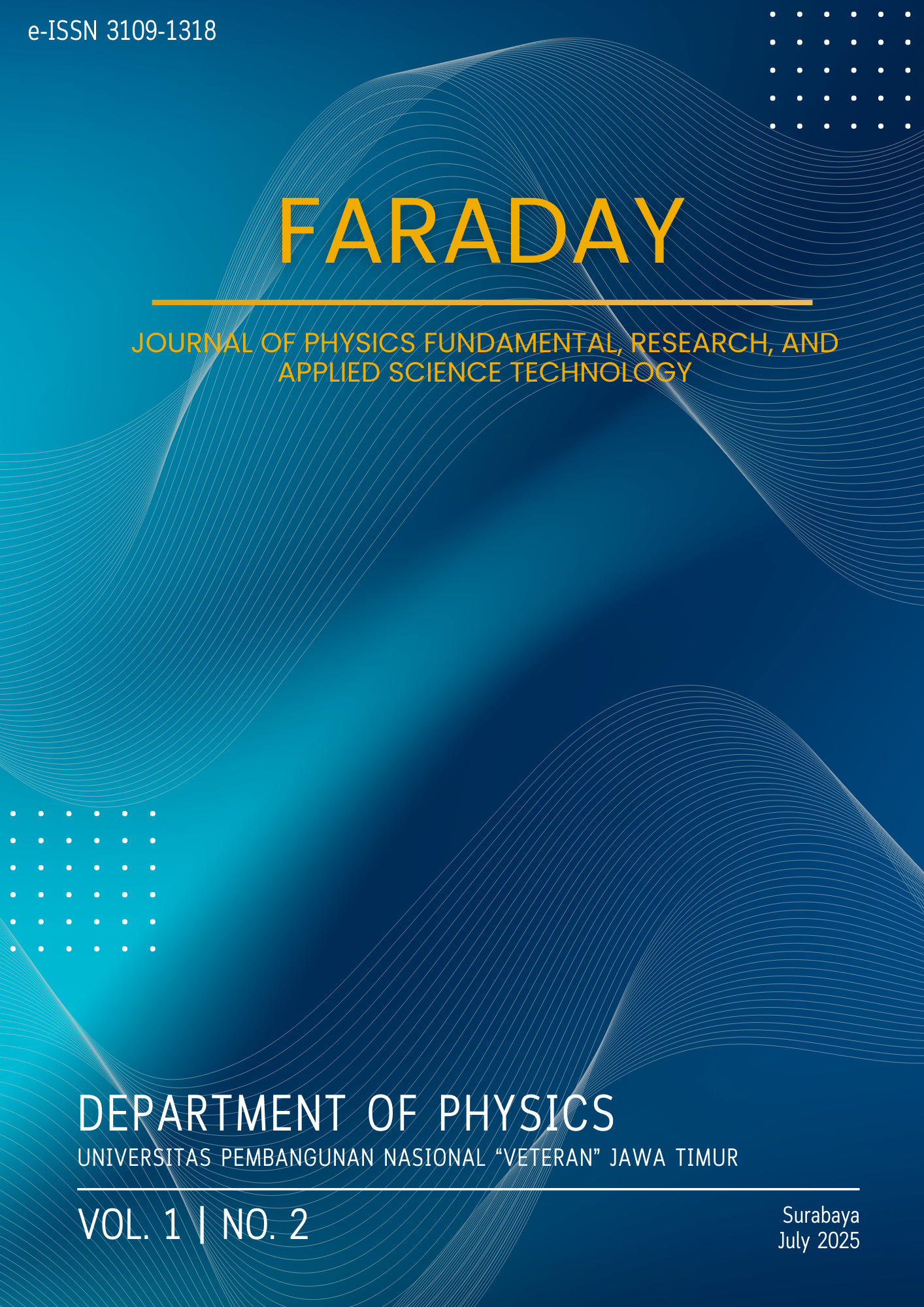Earthquake Analysis Using the Probabilistic Seismic Hazard Analysis (PSHA) Method in Palu City
DOI:
https://doi.org/10.33005/faraday.v1i2.18Keywords:
Palu City, Earthquake, Probability, Spatial DistributionAbstract
Palu, Indonesia, is a region with high seismic activity due to its location on the active Palu-Koro fault line. This study aims to analyze the probability of earthquakes, the spatial and temporal distribution of earthquake occurrences, and disaster mitigation efforts in anticipation of earthquakes in the region. Earthquake data in Palu City were analyzed based on magnitude, depth, and frequency of occurrence. The results indicate that most earthquakes occur at shallow depths ranging from approximately 10 to 56.8 kilometers, with a dominance of moderate magnitude (5.0–5.7 M_w). Over the past two decades, there has been an increase in the temporal occurrence of earthquakes, with a significant surge in 2018 when a magnitude 7.5 earthquake triggered a tsunami and liquefaction. Probability analysis indicates that earthquakes with high seismicity indices are highly likely to occur within a 10- to 50-year timeframe. The spatial distribution reveals that earthquakes tend to be concentrated around the Palu-Koro fault, the primary source of seismic activity in the region. These findings provide important insights into the seismic patterns of Palu City and can inform community preparedness and disaster mitigation strategy development.
Downloads
References
Badan Meteorologi, Klimatologi dan Geofisika & Pusat Studi Geologi. (2018). Laporan Analisis dan Evaluasi Dampak Gempa Bumi serta Tsunami di Palu dan Donggala, Sulawesi Tengah. Retrieved from https://www.bmkg.go.id
Bao, H., Ampuero, J.-P., Meng, L., Fielding, E. J., Liang, C., Milliner, C. W. D., … Huang, H. (2019). Early and persistent supershear rupture of the 2018 magnitude 7.5 Palu earthquake. Nature Geoscience, 12(3), 200–205. https://doi.org/10.1038/s41561-018-0297-z
Bellier, O., Sebrier, M., Beaudouin, T., Villeneuve, M., Braucher, R., Bourles, D., … Pratomo, I. (2001). High slip rate for a low seismicity along the Palu-Koro active fault in central Sulawesi (Indonesia). Terra Nova, 13(6), 463–470. https://doi.org/10.1046/j.1365-3121.2001.00382.x
Bellier, O., Sébrier, M., Seward, D., Beaudouin, T., Villeneuve, M., & Putranto, E. (2006). Fission track and fault kinematics analyses for new insight into the Late Cenozoic tectonic regime changes in West-Central Sulawesi (Indonesia). Tectonophysics, 413(3–4), 201–220. https://doi.org/10.1016/j.tecto.2005.10.036
Cornell, C. A. (1968). Engineering Seismic Risk Analysis. Bulletin of the Seismological Society of America, 58(5), 1583–1606.
Hamilton, W. B. (1979). Tectonics of the Indonesian region (Vol. 1078). U.S. Government Printing Office.
Jalil, A., Fathani, T. F., Satyarno, I., & Wilopo, W. (2021). Liquefaction in Palu: The cause of massive mudflows. Geoenvironmental Disasters, 8(1), 21. https://doi.org/10.1186/s40677-021-00194-y
Jaya, A., Nishikawa, O., & Jumadil, S. (2019). Distribution and morphology of the surface ruptures of the 2018 Donggala–Palu earthquake, Central Sulawesi, Indonesia. Earth, Planets and Space, 71(1), 144. https://doi.org/10.1186/s40623-019-1126-3
Jayadi, H., Santosa, B. J., Warnana, D. D., Zulfakriza, Z., Jamroni, R., Supendi, P., … Meidji, I. U. (2023). A Preliminary Tomography Inversion Study on the Palu Koro Fault, Central Sulawesi Using BMKG Seismic Network. IOP Conference Series: Earth and Environmental Science, 1227(1), 012032. https://doi.org/10.1088/1755-1315/1227/1/012032
Kusumawardani, R., Chang, M., Upomo, T. C., Huang, R.-C., Fansuri, M. H., & Prayitno, G. A. (2021). Understanding of the Petobo liquefaction flowslide by 2018.09.28 Palu-Donggala Indonesia earthquake based on site reconnaissance. Landslides, 18(9), 3163–3182. https://doi.org/10.1007/s10346-021-01700-x
McGuire, R. K. (1976). FORTRAN Computer Programs for Seismic Risk Analysis. UUS Geological Survey Open-File Report, 76–67.
Merz, H. A. (1973). Probabilistic Seismic Hazard Analysis: A Methodology for Quantitative Assessment. Earthquake Engineering Research, 11(2), 215–230.
Pakpahan, S., Ngadmanto, D., Rohadi, S., Widodo, H. S., & Susilanto, P. (2015). Analisis Kegempaan di Zona Sesar Palu Koro, Sulawesi Tengah. Jurnal Lingkungan dan Bencana Geologi, 6(3), 253–264.
Socquet, A., Hollingsworth, J., Pathier, E., & Bouchon, M. (2019). Evidence of supershear during the 2018 magnitude 7.5 Palu earthquake from space geodesy. Nature Geoscience, 12(3), 192–199. https://doi.org/10.1038/s41561-018-0296-0
United States Geological Survey. (2024). Earthquake Data and Monitoring Systems. Retrieved from http://earthquake.usgs.gov/earthquakes/search
Downloads
Published
Issue
Section
License
Copyright (c) 2025 Harsano Jayadi, Icha Untari Meidji, Irna Hidayat, Abdullah

This work is licensed under a Creative Commons Attribution 4.0 International License.














